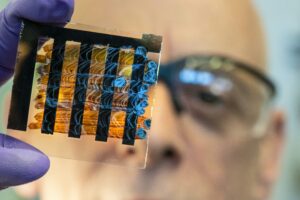
A groundbreaking study by researchers from Tohoku University, Tokyo University of Science, and the Institute for Molecular Science has revealed that the precise addition of a single silver (Ag) atom can significantly enhance the light-emitting properties of high-nuclear silver nanoclusters (NCs). The study, published in the Journal of the American Chemical Society on September 30, 2025, documents a remarkable 77-fold increase in photoluminescence (PL) quantum yield (QY) at room temperature, marking a significant advancement for optoelectronics and sensing technologies.
Photoluminescence quantum yield is a critical metric for assessing how efficiently a material can absorb energy and convert it into light. This improvement has profound implications for technologies such as OLEDs used in TV screens. Despite the inherent low PL efficiency of Ag NCs, their unique optical properties hold significant promise for future applications.
Unveiling the Structure-Property Relationship
To explore the structure-property relationship in greater depth, the research team synthesized and compared two closely related anion-templated Ag NCs: [SO4@Ag78S15(CpS)27(CF3COO)18]+ (Ag78 NC) and [SO4@Ag79S15(iPrS)28(iPrSO3)15(CF3COO)4] (Ag79 NC). Both NCs share a common structural framework, with the key difference being the addition of a single silver atom in the outermost shell of Ag79 NC.
This addition was achieved through subtle modifications of the surface-protecting ligands, particularly the in-situ generated iPrSO3- group, which created a void within the NC framework, allowing the extra atom’s incorporation. While the core structures remained largely unchanged, the shell modification had profound effects.
The Impact of a Single Silver Atom
In the Ag79 NC, the added silver atom enhanced radiative decay rates and resulted in a more rigid cluster. This rigidity effectively suppressed non-radiative decay pathways that typically reduce luminescence efficiency. The combination of enhanced radiative decay from symmetry reduction and reduced non-radiative losses from structural rigidity enabled the Ag79 NC to exhibit a remarkable 77-fold improvement in PL quantum yield over Ag78 NC at room temperature.
“This is the first clear evidence that the incorporation of just one extra silver atom, guided by ligand design, can drastically boost performance,” Professor Yuichi Negishi explained. “Our findings open a pathway to rationally engineer efficient light-emitting nanoclusters through atomic-level structural modifications.”
Future Implications and Applications
With this new advancement, researchers foresee new opportunities for deploying silver nanoclusters in high-performance light-emitting devices, bioimaging, and catalytic systems, where efficient luminescence at room temperature is critical. The breakthrough could lead to more energy-efficient and cost-effective technologies in various fields.
The study’s authors, including Aoi Akiyama, Sakiat Hossain, Sourav Biswas, and others, have paved the way for further research into the potential of silver nanoclusters. The findings suggest that even minor atomic-level modifications can lead to substantial improvements in material performance, a concept that could be applied across various scientific disciplines.
This development follows a growing trend in nanotechnology research, where the focus is increasingly on manipulating materials at the atomic level to achieve desired properties. As the field continues to evolve, the implications of such research are likely to extend beyond current applications, potentially revolutionizing how we approach material science.
The publication details are as follows:
- Title: Triggering Photoluminescence in High-Nuclear Silver Nanoclusters via Extra Silver Atom Incorporation
- Authors: Aoi Akiyama, Sakiat Hossain, Sourav Biswas, Takafumi Shiraogawa, Pei Zhao, Mana Nakamoto, Daiji Ogata, Tokuhisa Kawawaki, Yoshiki Niihori, Junpei Yuasa, Masahiro Ehara, Yuichi Negishi
- Journal: Journal of the American Chemical Society
- DOI: 10.1021/jacs.5c10289
As the scientific community continues to explore the potential of nanoclusters, the findings from this study could serve as a catalyst for future innovations, driving advancements in both theoretical and applied research.







